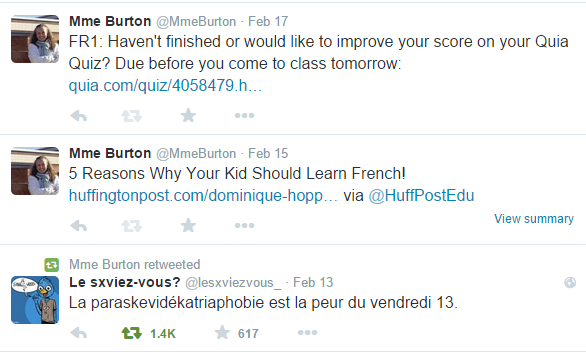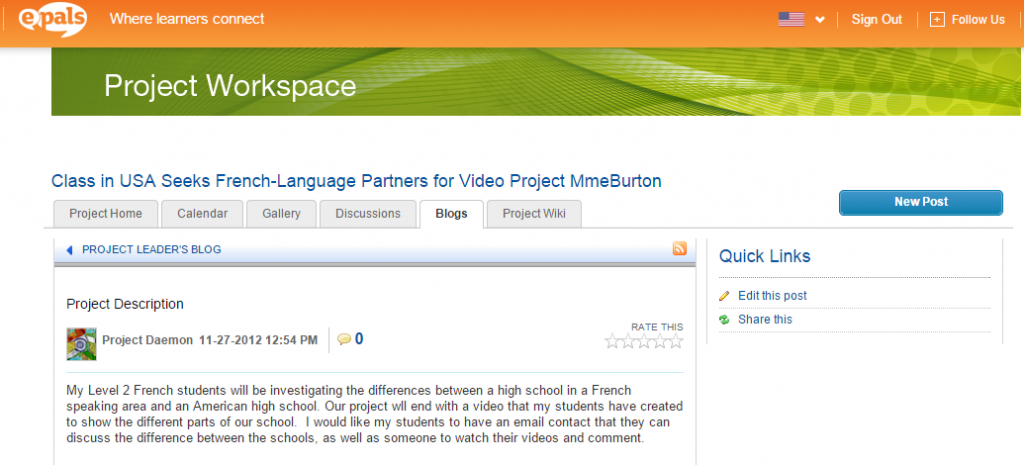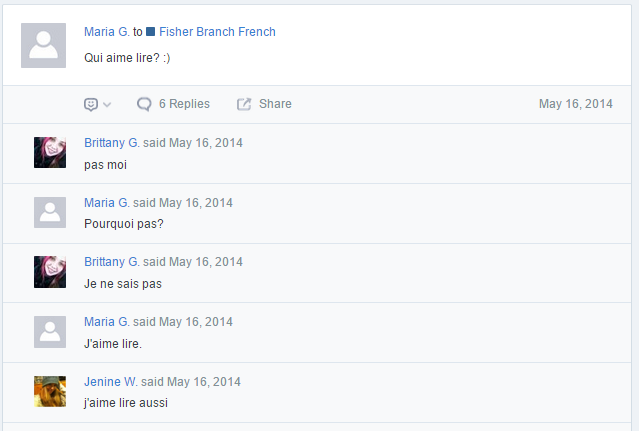Promote and model digital citizenship and responsibility
Teachers understand local and global societal issues and responsibilities in an evolving digital culture and exhibit legal and ethical behavior in their professional practices.
a. Advocate, model, and teach safe, legal, and ethical use of digital information and technology, including respect for copyright, intellectual property, and the appropriate documentation of sources
Through my coursework in Introduction to Digital Media, I learned about copyright and the differences between the different licenses that exist. I learned what a Creative Commons license is and how to give attribution to the creator. I this class, I created a short video that I use to introduce my Level 2 students to Paris prior to a unit that we do to study the city. I used a variety of different media in the video from video footage to music to researched statistics. In the video, I made sure to give attribution to those sources. This acts as an example to students who do the same in their projects in all of the subjects that they study.
b. Address the diverse needs of all learners by using learner-centered strategies providing equitable access to appropriate digital tools and resources
A few years ago, I had a student in class who was legally blind. While this student appeared to learn in the same manner as his classmates, there was one major difference, this student could not read the textbook. When I had this student in class, tablets were not readily available and my best resource to help this student was to make large print copies. Today, technology offers a variety of answers to the problem that this student had in my class. Since having Alex in class, I have been more aware of the diverse needs of students. When learning to code in html in Introduction to Web Development, I learned how to include coding for images that could be read and understand by someone who is visually impaired, for example including Alt text that would provide information for someone who cannot see an image. I learned how to validate a website through the W3C Schools Validation Service in order to make sure that websites are accurately coded to be read by multiple browsers so that text-to-speech software will accurately decipher the text of the site.
Additionally, students who are not able to hear and understand my video lessons can access the same information through our Online Textbook at Holt McDougal Online(log-in credentials required for access). Our Online textbook can be read by text-to-speech software for those students who cannot see it, but for those students who need to hear a more detailed explanation than what is offered in the textbook can listen to my video explanations. In the artifact listed below, I have given students multiple ways to access the information from videos to online textbook to printed textbook, students can choose the method that works best for their individual needs. Through my experiences and what I have been taught in Intro to Web Development, I am now more aware that these needs exist and I can take appropriate measure to meet those needs.
Artifact: (Validated) Introduction to Web Development Basic Website
Artifact: French 1 Chapter 1 Page of my website
c. Promote and model digital etiquette and responsible social interactions related to the use of technology and information
Our frequent use of technology in my classroom, both for learning and practice and for communication with native French speakers requires that guidelines for technology use be set immediately when students enter my class. Along with our class syllabus, I give students my technology use guidelines. This explains to students why I encourage the use of electronic devices, how we will be using those devices, as well as some of the frequent apps and websites that we use. Almost immediately after the school year begins, we begin communicated with our partner classes in France. Since we communicate via Edmodo, I accompany my directions on how to create an Edmodo account with the “Digital Citizenship Guidelines” that Edmodo has published in their resources.
Artifact: Electronic Use Policy
Because the use of social media is so prevalent among my students, I feel strongly that I need to be a positive voice. Several years ago, my students asked me to use Twitter as a means to relay due dates and reminders. Eventually, I began to use Twitter as an additional means to add to our curriculum. Soon after, I students started to follow a few of my boards on Pinterest. Both platforms provide excellent ways for me to share more about the French language and culture. Students enjoy learning these extra bits of information, but are also seeing an example of a positive use for social media. They are also free to share songs or other interesting sites that they come across with me. They are always excited when I “favorite” or “retweet” something that they have shared with me.
d. Develop and model cultural understanding and global awareness by engaging with colleagues and students of other cultures using digital age communication and collaboration tools
Working with teachers in French teaching countries is one of the most exciting things that I get to do as a French teacher. It is always intriguing to find out how teachers in other countries instruct and reinforce their learning objectives. I have been fortunate to have found several great teachers around the globe who I have been able to learn from. For the past several years, I have used ePals to find teachers who would be willing to do some sort of classroom exchange with my students and I. When I started my Project Based Learning Unit with my Level 2 students, I knew that my students would need to have access to native French speakers in order to gain first-hand knowledge. I used ePals to search out an appropriate match by posting our class project onto ePals. Within a few weeks, I started to get responses from French speaking teachers who were interested in participating with their students. I continue to post the same project and since have met teachers world-wide. Some of these teachers have been able to involve their students with a class exchange, others have simply shared information or pictures so that my students can learn from them, as well.
Artifact: ePals Project Description (Must have ePals account to view)
Social Media outlets have helped me to create a Personal Learning Network that includes teachers from around the world. Twitter, Pinterest, and Facebook are obvious choices to create connections with other teachers. In addition to the more popular Social Media giants, I have enjoyed making connections with teachers via Edmodo. I belong to several groups on Edmodo, including groups for French teachers, groups for teachers who use technology, as well as teachers who teach World Languages. Several schools from the US and Canada joined a group with the purpose of gaining an understanding of our different cultures, as well as practicing our target language. Teachers and administrators in these schools post polls, quizzes and random questions in order for other teachers and students to better understand each other, or as is truly the case, gain an understanding that even though we are all thousands of miles apart, we have a lot in common. Since my students are all on Edmodo for our class information and for communication with our partner class, I also give them the Edmodo code for this “Fisher-Branch French” group. It gives them one more opportunity to practice their language skills, while learning about the cultures and traditions of native French speakers. As do all of the teachers in this group, I participate in the polls, so my students can see me model appropriate use of this form of social media. Since it is on Edmodo, students know that it is a completely monitored platform and that all behavior be appropriate.
Artifact: Screen Shot of Edmodo Group


